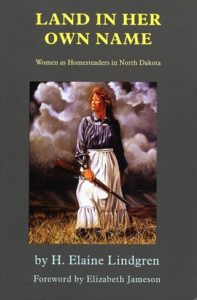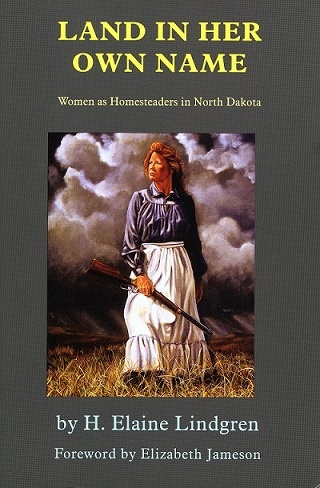Land in Her Own Name
History is the sum total of choices and actions that make up the past. A historic record is evidence that is left behind for those in the present and future to read or ignore, interpret, try to understand.
Do you ever wonder about your ancestors? How did they live? What choices did they make? What events shaped their lives?
One of the best known pieces of U.S. public land legislation is the Homestead Act of 1862. This land act signed into law by President Lincoln brought thousands of people west. According to Elizabeth Jameson, who wrote the forward to “Land in Her Own Name: Women as Homesteaders in North Dakota”, between 1868 and 1955 the United States government distributed almost 250 million acres of land to private individuals. In exchange, homesteaders were expected to pay a small fee, improve the land and live upon it for at least 5 years.
The perception is that homesteaders were men or families headed by men. In reality, thousands of single women and women with children homesteaded as well.
 “Land in Her Own Name: Women as Homesteaders in North Dakota” by E. Elaine Lindgren is a study of just 306 of the women that chose to participate in the western movement and settlement or resettlement of land in the late 1800s and the early 1900s.
“Land in Her Own Name: Women as Homesteaders in North Dakota” by E. Elaine Lindgren is a study of just 306 of the women that chose to participate in the western movement and settlement or resettlement of land in the late 1800s and the early 1900s.
These women came from a variety of backgrounds and ethnic groups. Each made the decision to homestead in North Dakota, and filed preemption, homestead or tree claims in their own names. Her work not only draws upon the records themselves, but also from questionnaires, interviews, letters, documents and pictures provided by a sample of these homesteaders and/or their friends and relatives.
It is important to note here that married women could not file a claim in their own name, unless they were the designated head of household; so these are not women that followed their husband’s desire for land. These are all women that chose on their own accord to participate in the westward movement and settlement of the United States.
Like most settlers, many of these women came with friends or family, and established their homes nearby. Yet their choices and experiences provide additional insight into the makeup and historical development of North Dakota; and shed light on opportunities available to women during this time period.
Lindgren’s work opens the door on the motivations, lives and experiences of the women in the study. She has placed tables of information amongst pictures, letters and personal stories. Lindgren provides analysis without detracting from the personal stories.
One hundred percent of the women in her study “proved up”. Some chose to stay on their homestead for the rest of their life. Some sold it and used it to finance their life elsewhere. One sold hers to pay her mother’s medical bills. Some left, but kept the land for the rest of their lives, using rent from the land to generate revenue. Others lost their land to economic woes.
If you’d like a glimpse into the lives of women that homesteaded in North Dakota, check out this book. If this subject interests you, the notes provided by Elizabeth Jameson at the end of the foreword and Lindgren at the end of the book provide a number of articles, journals and books for further exploration.


This is a very eye-opening post. The role women played in various aspects of our history is often downplayed. I’m delighted to learn something new today! Thank you for sharing!
Betty, this is fascinating to read that women participated in the Homestead Act as single women or heads of household. I had no idea that women had those types of rights back in those ages.
It is a testament to the courage and fortitude of those women who pulled up roots and took up the government’s offer to live on that land–presumably sight unseen–and to improve the land — as the terms and conditions stated.
That 100 percent of the women in this study ‘proved up’ is also remarkable. The one that stood out for me is the woman who sold her land to pay her mother’s medical bills. I would like to think that by grabbing this homesteading opportunity, staying on the land, improving it, and then being able to sell it to help her mother, then this was truly a life-saving chance for this woman and her mother.
Thank you for sharing this story and this book. It’s a remarkable piece of history.
Betty –
Great write-up on the history of the Homestead Act of 1862 as it deals with women.
You provide interesting insights into the lives of women that homesteaded in North Dakota. The book you mentioned, “Land in Her Own Name: Women as Homesteaders in North Dakota”, would be an excellent resource for anyone interested in learning more about these women and their experiences. It *sounds* like it could be a source for a history paper as well as a very, very interesting read for anyone interested in history.
Thanks for sharing!
Thank you for sharing this information. I was not familiar with this period in history and will certainly pick up a copy of the book and learn more.
I love learning something about US history that has been ‘hidden’ in more traditional narratives. Thanks for bringing this to light, Betty!
And as a former scholar of primary resources, I love how this story is able to be told because of the documents, records, letters and more left behind by these amazing women. So that the author can bring their story to light – because it’s just as much a part of our history as the more common stories shared in textbooks. Why we need to keep saving primary sources, in whatever format they come in now, so stories like this can be told in the future.
Thank you, Benecia! Yes, more rights than we are commonly told.
This was interesting to learn all of these details. I’m glad to see that some women did have some rights even back then.
Glad to share it, Jennifer! Yes, all those documents, records, letters, postcards, journals, etc. really do matter. Thank you very much for reenforcing that concept.
Very glad I could bring it to your attention, Connie.
Thank you, Paul. I recommend it.
Thank you, Melissa. I am glad to share a window on that piece of history that we seldom hear about.
Thank you so much for sharing about the Land in Her Own Name book. It’s cool to learn that lots of women claimed their own land.
It’s cool to learn about your ancestors. I created a family tree book back in high school.
Betty, thank you so much for sharing this. I am forever intrigued by the history of this country, especially that which isn’t often brought to our attention through the expected outlets. One of my favorite pastimes is to read stories (when I can find them) of the wives/sisters/mothers..etc. of the men we so often learn about. This is right up my alley, I’m excited to learn more about this! I appreciate that you have shared enough to pique my interest, but not so much detail that I’m no motivated to seek out more info.
I homeschool my daughter and we’ve been doing a two-year American History curriculum. We’ve been focused on this time period for two years, but the curriculum hasn’t mentioned this. As a single woman myself, I’m always trying to role-model to my daughter that we can pursue our dreams regardless of any circumstances. I’m excited to dig into this book with her so thank you for making me aware of it!
Thanks Betty,
I was not aware that women were also homesteaders in North Dakota. The book by Land could be an interesting read. Will definitely look up the title once this challenge is over.
Thank you Betty! I LOVE reading about women in history as traditional text books we learned from in school often minimizes or neglects the role of women.
How fascinating, being from Oklahoma most of my life I was familiar with the land runs here but had no idea that women were homestead owners of land in ND. I am not sure that there were independent women in the land run here but now I will check it out. The book sounds very interesting and I will have to check it out. Thanks for bringing this to the public attention. Considering women didn’t have the right to vote at that time I find it quite unusual that they were single land owners! So many opportunities I didn’t even know existed way back then!
There were independent women in the Oklahoma Land Rush as well, Jodi.
I am sorry to hear your curriculum did not mention that single women could own land Rebecca. Does it include the actual text of the Homestead Act? Single women homesteaded in what are now multiple states. I hope you and your daughter enjoy the book.
Betty, your review of Land In Her Own Name opened my mind to a way women achieved presence in the West by working hard alongside other women and men to build the frontier for themselves and their families. I wonder if they blended into other groups of women or if there was equality in land ownership and the work that was necessary to survive. I will be looking into this with new interest and a window into understanding the roles of women.
Your article opened my eyes to another way that women gained independence and built lives for themselves and their families. I had not realized women could own land and stake a claim in the new frontier. Land ownership is a huge step to building true wealth.
Thank you for sharing this beautiful story, I’ve learnt something about these women I had no idea about. Great talent for writing, I loved it and wanted to know more! 😉
Thank you, Mailys